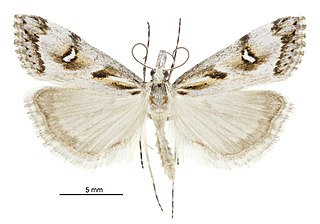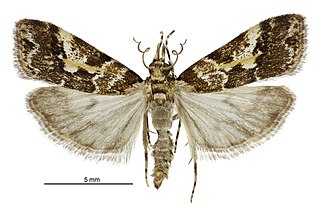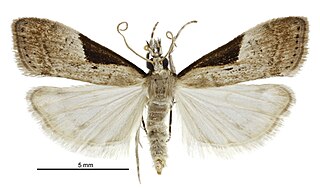
Heterocrossa gonosemana is a species of moth in the family Carposinidae. It is endemic to New Zealand.

Scoparia petrina is a species of moth in the family Crambidae. It was named by Edward Meyrick in 1884. Meyrick gave a description of the species in 1885. It is endemic to New Zealand.

Gadira leucophthalma, the beaked moss moth, is a moth in the family Crambidae. It is endemic to New Zealand. It is found in the south eastern side of the South Island down to Banks Peninsula. G. leucophthalma inhabits the foredunes of coastal areas. The larval host is unknown but it has been hypothesised that the larvae feed on moss. The adult moths are day flying although some specimens have been trapped at night via light traps. Adults are commonly on the wing from March to April. This species has been classified as Nationally Vulnerable by the Department of Conservation.

Eudonia characta is a species of moth in the family Crambidae. It was named by Edward Meyrick in 1884 and later more fully described the species. It is endemic to New Zealand.
Eudonia homala is a moth in the family Crambidae. It was described by Edward Meyrick in 1885. It is found in Australia, where it has been recorded from South Australia.

Eudonia legnota is a moth in the family Crambidae. This species was named by Edward Meyrick in 1884. It is endemic to New Zealand.

Eudonia leptalea is a moth in the family Crambidae. This species is endemic to New Zealand, including the Chatham Islands.

Eudonia manganeutis is a moth in the family Crambidae. It was named by Edward Meyrick in 1884. It is endemic to New Zealand.
Eudonia perierga is a moth in the family Crambidae. It was described by Edward Meyrick in 1885. It is found in Australia, where it has been recorded from Tasmania.

Eudonia periphanes is a moth in the family Crambidae. It was named by Edward Meyrick in 1884. Meyrick gave a detailed description of this species in 1885. It is endemic to New Zealand.

Eudonia philetaera is a moth in the family Crambidae. It was named by Edward Meyrick in 1884. Meyrick gave a description of the adult moth in 1885. It is endemic to New Zealand.

Eudonia psammitis is a moth in the family Crambidae. It was named by Edward Meyrick in 1884. Meyrick gives a description of the species in 1885. It is endemic to New Zealand, including the Campbell Islands.

Eudonia pongalis is a moth in the family Crambidae. It was described by Cajetan Felder, Rudolf Felder and Alois Friedrich Rogenhofer in 1875. It is endemic to New Zealand.
Scoparia acropola is a moth in the family Crambidae. It was described by Edward Meyrick in 1885. It is found in Australia, where it has been recorded from Tasmania.
Scoparia anaplecta is a moth in the family Crambidae. It was described by Edward Meyrick in 1885. It is found in Australia, where it has been recorded from Tasmania.
Scoparia chiasta is a moth in the family Crambidae. It was described by Edward Meyrick in 1885. It is found in Australia, where it has been recorded from New South Wales.

Scoparia favilliferella is a moth in the family Crambidae. It was described by Francis Walker in 1866. It is found in Australia, where it has been recorded from Tasmania.
Scoparia gomphota is a moth in the family Crambidae. It was described by Edward Meyrick in 1885. It is found in Australia, where it has been recorded from Tasmania.
Scoparia philonephes is a moth in the family Crambidae. It is found in Australia, where it has been recorded from Victoria and South Australia.

Trachypepla protochlora is a moth of the family Oecophoridae first described by Edward Meyrick in 1883. It is endemic to New Zealand and is found in both the North and South Islands. The preferred habitat of this species is native forest and adults are on the wing from October until February. Adults can be variable in their green shaded colour as well as in the intensity of markings on their forewings. The greenish ground colouration of this moth ensures they are well camouflaged when at rest on green mosses and lichens.












